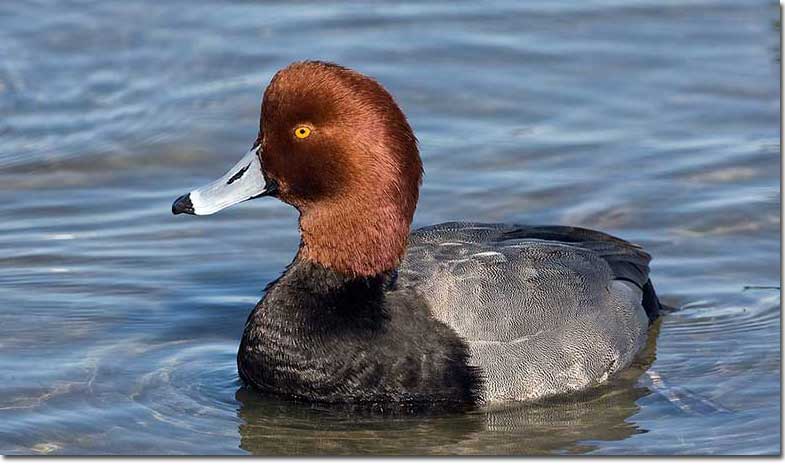The Redhead duck (Aythya americana) is a medium-sized diving duck found across North America. Recognizable for the vibrant chestnut-red heads of males, they inhabit diverse freshwater habitats during breeding and wintering, including marshes, ponds, and coastal areas.
They have some rather interesting behaviors, such as making sounds like a meowing cat or dumping their eggs into other nests, so let’s find out more about them.
On this page
Identification
Male
Male Redhead ducks have a gray body and wings. Their chest and rear are black, their belly whitish, and their head a rich reddish coppery color, hence the name. They have bluish-gray bills with a black tip and feet, and their eyes are yellow.
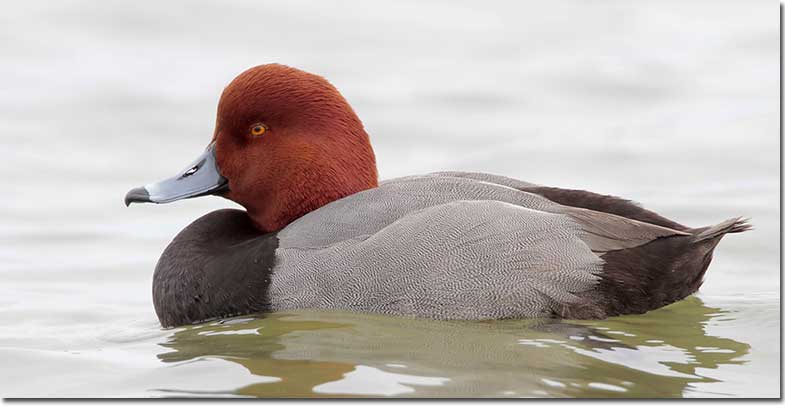
However, their plumage changes slightly depending on the season. In their non-breeding plumage (also known as eclipse plumage), their whole body becomes a more uniform grayish-brownish and their bills become dark gray. Their heads aren’t as vibrant anymore and look more chestnut brown.
Female
Female Redhead ducks’ plumage is more subdued compared to males, perfect for camouflage. They have a mottled brown body, with colors ranging from shades of brown to tan and whitish bellies.
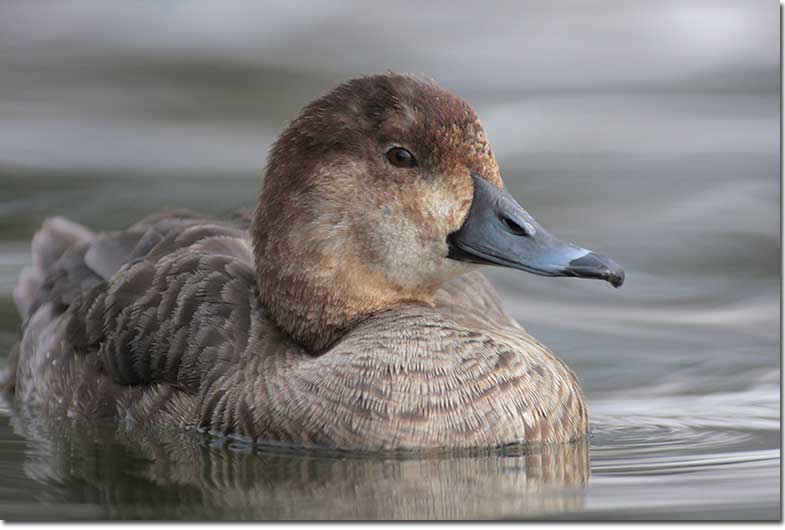
The head of a female Redhead is a lighter brown compared to the rest of its body and has a dark cap. Their neck may have a slightly lighter or more finely streaked appearance. They have a dark gray bill with a black tip and dark eyes.
In flight, the flight feathers of both sexes are a lighter shade of gray than the rest of the wing and have dark tips.
Vocalizations
Redhead ducks emit a range of sounds from quacks to distinct calls. During courtship, males let out a wheezy whee-ough or catlike meows. Once you’ve heard it, you’ll recognize these birds much faster.
They also give low err sounds, but their purpose is different depending on the sex. Males use it to threaten other ducks whereas females use it to get the male’s attention. Females also let out a deep kurr-kurr-kurr when searching for a nest site or threatening someone.
Food
Redhead ducks are omnivorous, but their diet depends heavily on the season. During the non-breeding season, especially winter, their diet is mostly plant-based. However, during the breeding season around 75% percent of their food is animal matter, especially when it comes to females.
Plant matter Redheads commonly eat includes various aquatic plants. Some of their favorites are pondweeds, algae, sedges, grasses, duckweeds, bulrush, wigeon grass, shoal grass, muskgrass, water lilies, and wild celery.
They source their protein from various small creatures, such as grasshoppers, midges, water fleas, scuds, snails, mollusks, and caddisflies, very rarely also small fish.
These ducks often forage in groups, especially during the non-breeding season. They can be found foraging in shallow water, dabbling on the water’s surface or upending to reach the bottom for submerged vegetation.
However, generally speaking, they are diving ducks. That means that they dive to the bottom of the body of water, generally a few feet deep, to search for food.
Nesting and Eggs
Redhead ducks are monogamous for the breeding season. They form pairs throughout December and January through various courtship rituals, such as males stretching their heads up in the air and calling like a cat and females responding in kind.
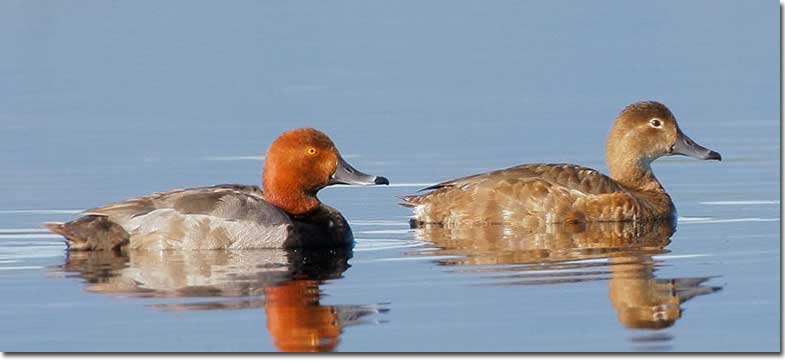
Females start the nest-building process after copulation. Redhead nests can be found on dry land, on islands, or even over water on dense vegetation, preferably cattails or bulrushes, and most often in marshes. It is a bulky construction made of thick and strong plants and can measure anywhere from 9 inches to 2 feet across. They often anchor it to the vegetation below and build a ramp to access the nest.
Redheads have 9-11, mostly 7-8 whitish eggs in a clutch. They are olive buff, or buffy brown eggs, and measure a bit over two inches long and a bit under two inches wide.
The male ditches as the incubation begins and leaves it all to the female. After 22-28 days, the eggs hatch, and the ducklings leave the nest after about a day.
The mother bird takes care of them and broods them, but they have to forage food themselves. As the offspring get 8 weeks old, the female abandons them, leaving them rather vulnerable, as they’re not able to fly for at least another 2 weeks.
Current Situation
Redhead ducks have a broad range that spans North America, extending from Alaska and northern Canada southward to the southern United States and Mexico. There are resident populations in California, a small part of the southeastern United States, and southernmost Mexico.
Breeding populations are found in the prairie pothole region of the northern Great Plains, as well as in other wetland areas across the northern parts of the continent. They migrate to Central America and the southern United States for the winter.
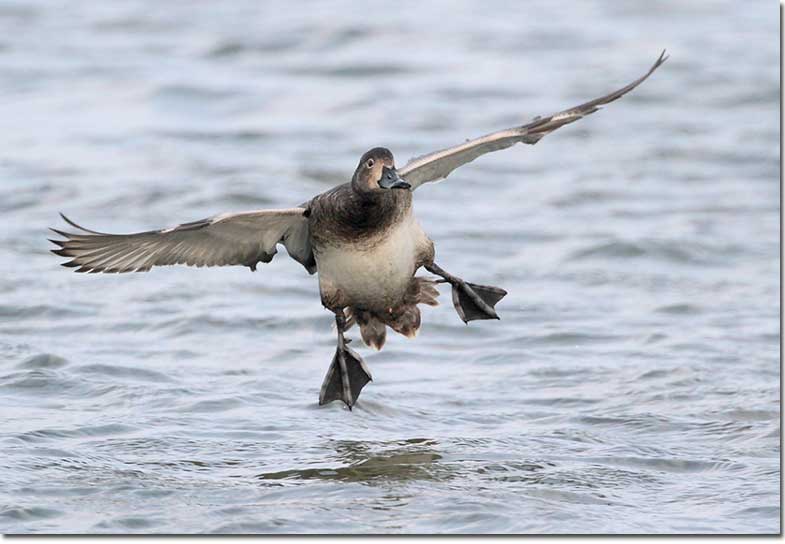
Redhead ducks inhabit a range of wetland environments, including shallow lakes, ponds, marshes, and prairie potholes during the breeding season. During migration and winter, they are often found in both freshwater and brackish coastal habitats, such as estuaries and lagoons.
Redheads are listed as of least concern on the IUCN Red List. Currently, it seems that their population is in an increase even though there have been some serious declines in the past due to habitat degradation, overhunting, and disturbance.
Facts
- Redhead ducks may hybridize with other duck species, such as the Canvasback or the Ring-necked Duck. Hybrids between the Redhead and the Canvasback can be fertile!
- The nesting behavior of female Redheads is rather peculiar. They can either lay and incubate their eggs on their own as is normal, or they can lay some eggs in others’ nests and incubate some on their own, or they may lay all their eggs in another nest!
- The mother bird imprints on her ducklings by letting out a low kuk-kuk-kuk sound right before the eggs hatch, so they know who to follow.
- Redheads know how to make an entrance. They either splash into water or zigzag for a smoother landing.
Similar Species
Redhead ducks look similar to a few other duck species that they may also hybridize with, such as the Canvasback, Greater Scaup, and Ring-necked Duck. Here is how to know which one is which.
Canvasback
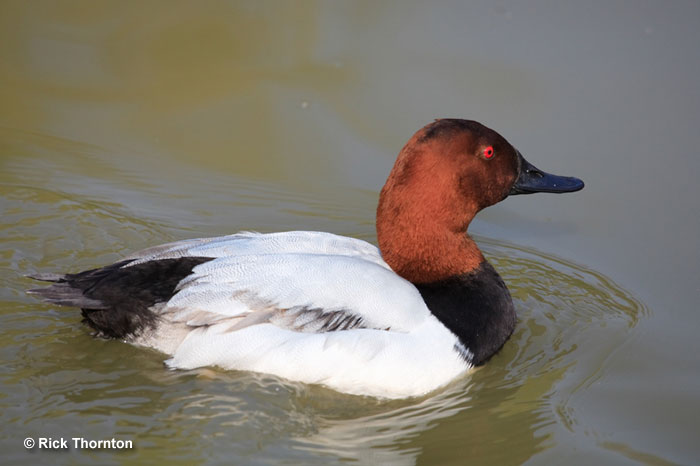
Canvasbacks have a similar range to the Redhead duck and inhabit similar areas with some minor differences. They’re also the ones with the most similar plumage. Male Canvasbacks have a whitish body, black chest and rump, a chestnut-colored head, a black bill, and red eyes. Females are brown with mottled gray wings and backs, dark eyes, and a black bill.
Canvasbacks are perhaps the most similar species to the Redhead ducks. There are still a couple of differences though. Canvasbacks have a rather flat head and are larger. Males have a white body, red eyes, and a black bill instead of a gray body, yellow eyes, and the slaty blue bill the male Redhead has. Females are very similar, but female Canvasbacks have grayish instead of brown wings and back.
Greater Scaup
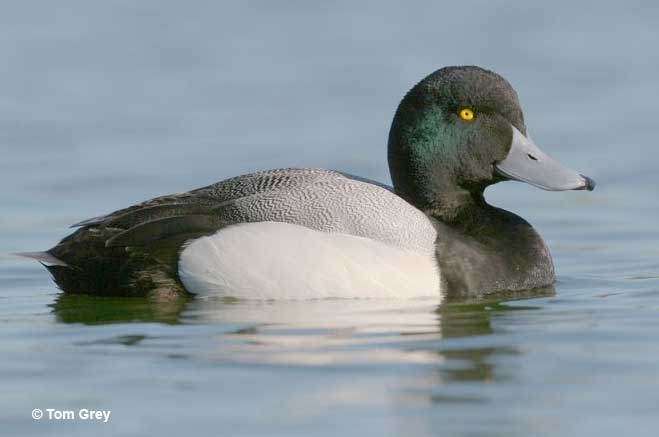
Greater Scaups primarily breed in the freshwater habitats of Alaska and Canada. During the winter, they migrate southward and can be found along coastal areas in the United States.
Males of these species are easier to tell apart than females. Male Greater Scaups have white sides instead of gray, a paler bill, and a dark head instead of a reddish one. Females have very similar plumage, but female Greater Scaups have yellow instead of brown eyes and a white ring around their bills.
Ring-necked Duck
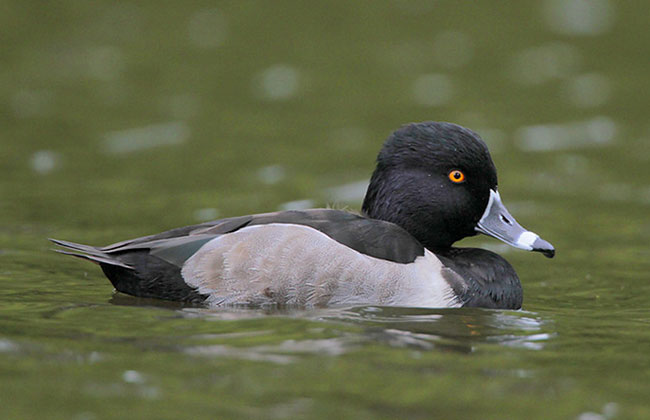
Photograph © Greg Lavaty
Ring-necked Ducks have a very similar range and habitats to Redhead ducks, albeit with minor differences. Males have a black head back, front, and rear, gray sides, yellow eyes, and gray bills with a black tip bordered by a white line. Females are mottled brown with a grayish head, brown eyes, and similar bills.
Males can be identified rather easily if you can see their color. Male Ring-necked Ducks have a black back instead of a gray one, a black head instead of a reddish-brown one, and white lines on their bills. Females are quite similar, however. They can be differentiated by their face and bills.
Frequently Asked Questions
How rare are Redhead ducks?
Redhead ducks are not rare, according to the IUCN Red List. They’re listed as of least concern with a population of 1,2 million mature individuals.
How long do redheads live for?
Redhead ducks live for 5-10 years in the wild, but they can live up to 20 years if they’re lucky or in captivity.
How deep do Redheads dive?
Redhead ducks generally dive to depths of about 3-9 feet, but they can dive as deep as 45 feet.
Where do Redhead ducks live?
Redhead ducks live in various wetland habitats across North America, breeding in central Alaska and Great Plains and wintering in open waters across the southern US and Mexico.

